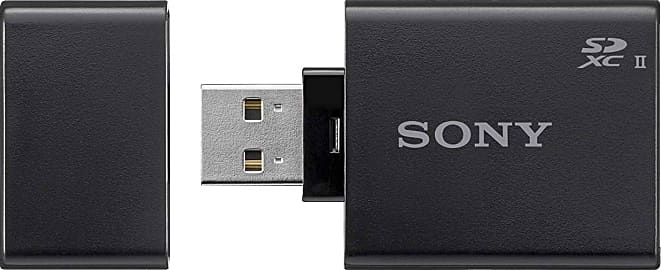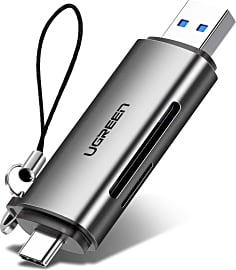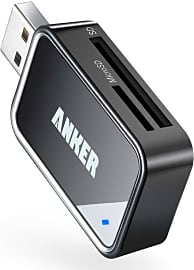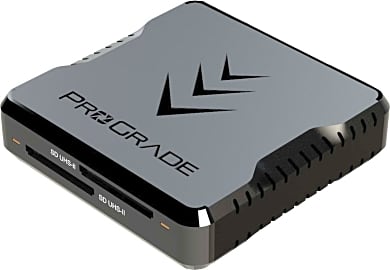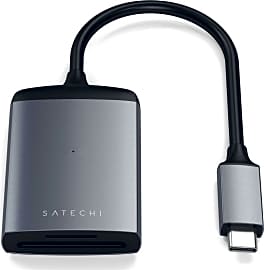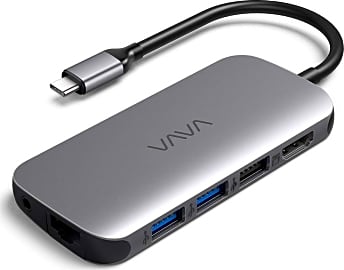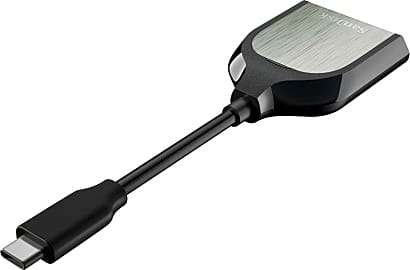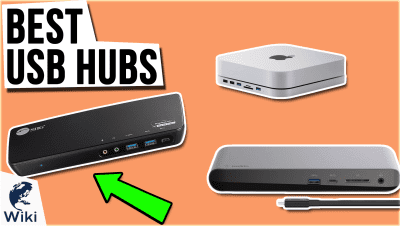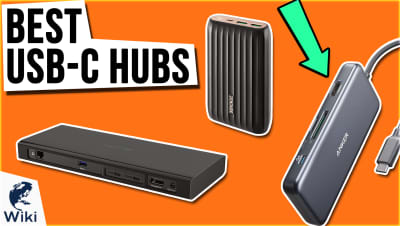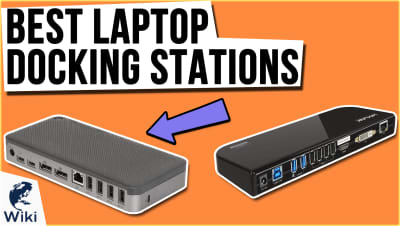The 10 Best USB Card Readers

This wiki has been updated 38 times since it was first published in March of 2016. Get fast and reliable access to all your media using one of these USB card readers. Ideal for photographers, videographers, design studios and printing houses, they can facilitate speedy transfers of images, videos, and other data, so you can keep the workflow moving smoothly. We've included models in our selection that work with all of the most popular formats, such as both SD sizes and CF cards. When users buy our independently chosen editorial recommendations, we may earn commissions to help fund the Wiki.
Editor's Notes
December 04, 2020:
For this update, we've removed the Kingston Digital FCR-HS4 and the Sony MRW-E90 due to availability issues and replaced the IOGear Quantum with a selection we believe offers better value.
We've added three new devices to our ranking, and updated the order of some of the other models. The Transcend TS-RDF5K is a convenient, portable, and very affordable choice that can handle both SD and MicroSD formats. The SmartQ C368 Pro is a versatile and cost-effective option that can access up to four cards simultaneously.
The Rocketek Super replaces the Sony MRW-E90 as the only device on this list capable of reading both XQD and SD formats. The XQD media format is a newer technology that focuses on the needs of enthusiast photographers and videographers. If you're looking for more options that support this particular format then make sure to take a look at our recommendations for XQD Card Readers.
November 22, 2019:
Depending on how much connectivity you really need, there are quite a few worthwhile choices available at a range of prices. The Sony MRW-S1 is about as simple and fast as they come, and the Anker B2A is close behind in portability, but far behind in speed. The SanDisk Extreme Pro is also remarkably quick and durable, as is the Satechi Type-C, though the former is a bit cheaper than the latter.
Actually, if you're talking about speed, the ProGrade Digital Dual-Slot is pretty tough to beat; it can fully leverage two SD cards at once, while most others drop at least a little bandwidth when accessing multiple cards. This is partially because the ProGrade uses the second-generation USB 3.1 standard which is twice as fast as SuperSpeed USB. The Sony MRW-E90 is another ultra-fast option, and supports XQD cards, so while it's quite capable it's also quite expensive and is overkill for consumers not using one of Sony's high-end cameras. The UGreen 50706 is especially nice to carry around because of its keychain loop that might help to keep from misplacing it, and the IOGear Quantum has SD and CF slots that can all be read at the same time.
There are also a couple of multifunctional hubs that we'd highly recommend. The Kingston Digital FCR-HS4 is relatively old but still quite popular due to its reliability and vast selection of compatible card formats. And for a powerful and versatile USB-C hub, get the Vava UC010, which expands considerably on the port selection of modern, USB-strapped laptops.
For that matter, if you do need considerably more connectivity, check out some of the best USB Type-A and Type-C hubs or consider a docking station if you're willing to make a slightly larger investment.
Special Honors
Sony MRW-S3 It's one of their newest products, and Sony claims that the MRW-S3 is the fastest USB-C hub yet to hit the market. What's pretty certain is that it will max out just about any of the fastest SD and microSD cards out there right now... if you can get your hands on one of the hubs. Oh, and if you can find one, it'll probably cost quite a bit. sony.com
Reading The Future
What'll I do when the industry stops making compact flash card readers and my D700 is still shooting like a newborn?
While I'm not old enough to have been a holdout in the digital photography revolution, clinging to my film cameras and unprocessed negatives like a misting rain clings to your windshield no matter how good your wipers are, I am old enough to have made my biggest camera investment in a Nikon D700. I will argue to this day that its 12 megapixel sensor will outperform anything else on the market.
The big problem with the D700, though, is that it–and any big body Nikon or Canon made before it–only writes to compact flash cards. As far as I know, photography is the only industry that still uses compact flash, and as more and more of our writing transfers to SD and micro SD, card readers that can fit a compact flash card will go the way of the dinosaurs.
For now, there are still card readers available with slots for compact flash, and you can even see some of them here on our list. Those card readers, as well as Apple's decision to continue including SD card slots on their computer bodies, are pieces of tech we can't expect to last, especially as port connections slowly but surely consolidate around USB standards.
Whether or not you have an SD card slot on your computer, these card readers are life savers for anyone with media to transfer. In some cases you'll use them to grab photos, videos, or other files off of your SD and micro SD cards, as they'll work as intermediaries between the card and your computer without any additional software needed.
In other cases, you can use some of these card readers as USB extenders, multiplying the number of available USB ports open to your computer. This will particularly come in handy as computers reduce the number and variety of their ports in favor of less expensive, more streamlined circuitry.
What'll I do when the industry stops making compact flash card readers and my D700 is still shooting like a newborn? I'll weep for a moment, then I'll do what everybody who invested in Betamax had to do: I'll adapt.
Thunder Reigns
In order to know which USB card reader will serve you best, you're going to need to know a little bit about the hardware on your computer, as well as the purpose of your card reader–as in the kinds of cards you need to read. These little bits of information ought to narrow your choice down to one or two options, and you can let the prices and read/write speeds of the devices guide you from there.
If you have a newer computer, you might also see a port with a kind of lightning bolt symbol next to it.
To start with, look along the area of your computer that has all the ports. You'll probably recognize the USB symbol and its related port, since so many of our devices rely on that specific connection. If you have a newer computer, you might also see a port with a kind of lightning bolt symbol next to it. This is a Thunderbolt port, a USB-integrated port often referred to as Type-C. Type-C ports are situated to completely dominate the market within the next few years, and USB as we know it will slowly die out as a means of transferring data.
I have an older Apple laptop, so I can't even use these hot new Thunderbolt devices, which rules out a few of the readers on our list. In this transitional period, if you do have a thunderbolt port, you might have a reduced number of USB ports for your pre-Thunderbolt devices. Rather than investing in a half-dozen new cables for all of them, you can use some of the readers on our list to expand your Thunderbolt port to become a few available USB ports.
Some of these expansion readers only read one or two types of cards, however. If you've got a camera that shoots to compact flash, a micro SD card with a missing adapter, or any of the bygone XD cards Sony used to use, a more diverse card reader will be your best option, even if it doesn't have the Thunderbolt connectivity or USB expansion capabilities.
SD And USB: Brothers In Arms
I recently asked a young person (oh, boy, that makes me sound old) if he ever had to physically screw a cable into any of his computers. He looked at me like I was a three headed goat monster. What I was referring to in my question were the basic serial ports of my first computers, the ones that fit into place, and then were secured with tiny screws.
Before the time this little brat had learned to spell, USB connectors had already hit the market. Of course, this was well before the majority of device manufacturers began to focus their developments around USB integration. That wave wouldn't hit until the mid-2000s, when USB 2.0 came along with superior speed, convenience, and reliability. USB 2.0 also gave us the now-ubiquitous (for now, at least) USB flash drives–often called thumb drives or jump drives–that more or less killed every other form of physical file sharing.
Just before this revolution in USB technology, Panasonic, Toshiba, and SanDisk all launched Secure Digital, or SD cards, in 1999. In relatively short order, the photography industry, which had already developed readers for its compact flash cards that came out in 1994, jumped on the USB band wagon, and these readers were born.



